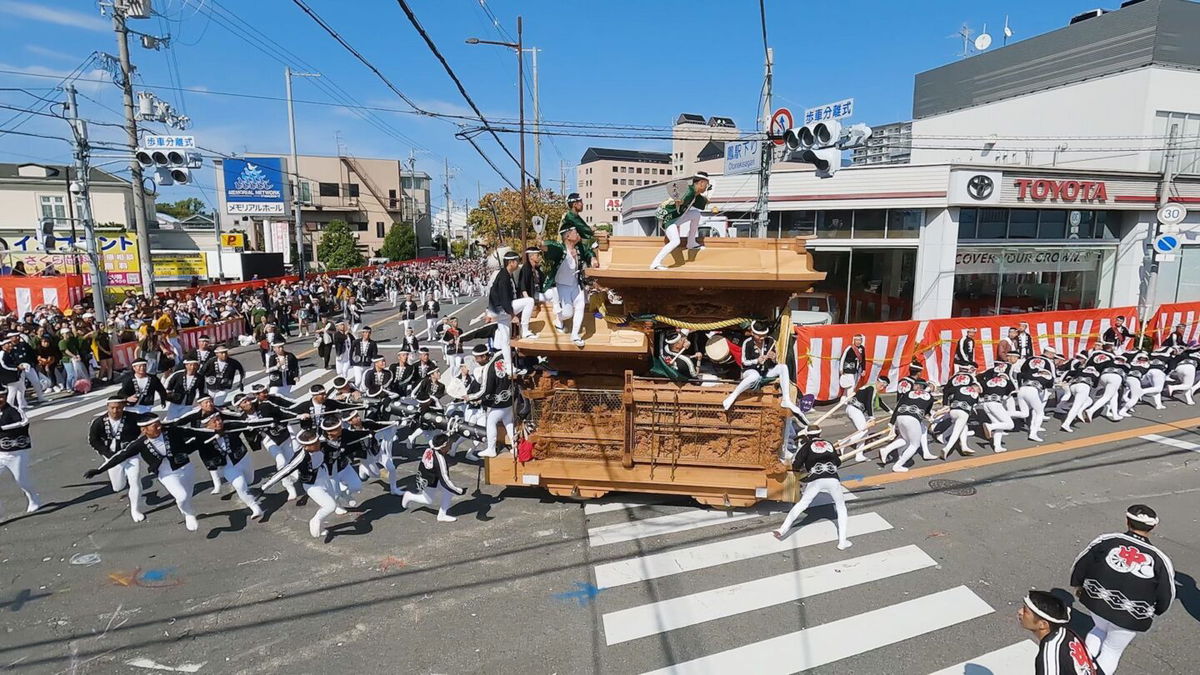Inside the wild world of Osaka’s dangerous, adrenaline-fueled float festivals

(CNN) — To a din of cheering crowds, rhythmic chanting and taiko drums, hundreds of people haul massive wooden floats through the streets of Osaka — while running as fast as they can. This chaotic spectacle is one of the Japanese prefecture’s “danjiri matsuri,” or float festivals.
Held over a few weeks in October, they’re considered one of the most dangerous events on Japan’s festival calendar. The floats weigh several tons, and accidents sometimes occur while navigating them around sharp corners. They can even be deadly, especially for those who ride on top of the moving danjiri, known as “daikugata.”
“Danjiri sometimes fall over or collide, and I’ve seen daikugata fall,” says Shinya Ogura, a six-time danjiri rider at one such festival in Osaka’s Otori region.
For Ogura, the view from the top — and the thrill of staying up there — is part of what makes the experience so addictive.
“I think it’s a very rewarding position,” he says. “My grandfather and father have participated since I was a child, and I’ve followed them.”
Passed down over generations, some estimate the festivals began around 300 years ago as a way for local communities to ward off illness and bad luck or to pray for a rich harvest.
A tradition rooted in craftsmanship
For centuries, danjiri festivals have also celebrated woodworking. “Daikugata” directly translates as carpenter; the festival’s prized role was once reserved for the people who made the floats. Each danjiri is adorned with hundreds of individual figures, chiseled by hand.
Today, artisans like Akihiko Maeda continue the tradition. The 48-year-old gave up riding the danjiri about a decade ago, but still builds and restores floats for communities in Osaka.
“I’ve been working mainly on danjiri for several decades now,” Maeda says. “I’m constantly trying to find ways to capture the cool poses of the sculptures, so that they look as if they’re about to start moving.”
Maeda says the process of making a bespoke danjiri can take five years. The district pays around $650,000 for each one.
“Once a danjiri is built, it’s used for an average of 70 to 80 years,” the artisan says.
But demand for Maeda’s work is waning as the number of festival participants declines.
With record-low birth rates across Japan, the country’s population is shrinking. In 2020, almost 28% of Osaka’s population was over 65, compared to the global average of just over 9%.
Kazuma Nakao, who has participated in Otori’s danjiri festival for over 40 years, says there aren’t enough physically-able people required to pull their float.
“We need to borrow people from other districts. Every town is like that now,” he says.
What this year’s cohort lacks in numbers, they make up for in enthusiasm. Some take part in multiple towns’ festivals, one after the other, a feat of endurance that lasts well into the evening.
Ogura hopes that increasing the global profile of danjiri festivals will help their traditions survive into future generations.
“I want people from overseas to see them when they come to Japan,” Ogura says. “I hope that this will continue to be a festival that small children can enjoy.”
The-CNN-Wire
™ & © 2024 Cable News Network, Inc., a Warner Bros. Discovery Company. All rights reserved.